Bichop R.H. (Ed.) Mechatronic Systems, Sensors, and Actuators: Fundamentals and Modeling
Подождите немного. Документ загружается.


18-16 Mechatronic Systems, Sensors, and Actuators
continuously tracks the same cycle of a ground wave signal can transfer frequency with an uncertainty
of about 1 × 10
−12
when averaged for 1 day.
NIST operates LF radio station WWVB from Fort Collins, Colorado at a transmission frequency of
60 kHz. The station broadcasts 24 h per day, with an effective radiated output power of 50 kW. The
WWVB time code is synchronized with the 60 kHz carrier and contains the year, day of year, hour,
minute, second, and flags that indicate the status of daylight saving time, leap years, and leap seconds.
The time code is received and displayed by wristwatches, alarm clocks, wall clocks, and other consumer
electronic products [2,7,15].
18.4.2.3 Global Positioning System
The Global Positioning System (GPS) is a navigation system developed and operated by the U.S. Depart-
ment of Defense (DoD) that is usable nearly anywhere on the earth. The system consists of a constellation
of at least 24 satellites that orbit the earth at a height of 20,200 km in six fixed planes inclined 55° from
the equator. The orbital period is 11 h 58 m, which means that each satellite will pass over the same
place on earth twice per day. By processing signals received from the satellites, a GPS receiver can
determine its position with an uncertainty of <10 m.
The satellites broadcast on two carrier frequencies, L1 at 1575.42 MHz and L2 at 1227.6 MHz. Each
satellite broadcasts a spread spectrum waveform, called a pseudo random noise (PRN) code on L1 and
L2, and each satellite is identified by the PRN code it transmits. There are two types of PRN codes. The
first type is a coarse acquisition (C/A) code with a chipping rate of 1023 chips per millisecond. The second
is a precision (P) code with a chipping rate of 10230 chips per millisecond. The C/A code is broadcast
on L1, and the P code is broadcast on both L1 and L2. GPS reception is line-of-sight, which means that
the receiving antenna must have a clear view of the sky [16].
Each satellite carries either rubidium or cesium oscillators, or a combination of both. These oscillators
are steered from DoD ground stations and are referenced to the United States Naval Observatory time scale,
UTC (USNO), which by agreement is always maintained within 100 ns of UTC (NIST). The oscillators
provide the reference for both the carrier and the code broadcasts.
GPS signals now dominate the world of high performance time and frequency transfer, since they
provide reliable reception and exceptional results with minimal effort. A GPS receiver can automatically
compute its latitude, longitude, and altitude from position data received from the satellites. The receiver
can then calibrate the radio path and synchronize its on-time pulse. In addition to the on-time pulse,
many receivers provide standard frequencies such as 5 or 10 MHz by steering an OCXO or rubidium
oscillator using the satellite signals. GPS receivers also produce time-of-day and date information.
A GPS receiver calibrated for equipment delays has a timing uncertainty of <20 ns relative to UTC
(NIST), and the frequency uncertainty is often <2 × 10
−13
when averaged for 1 day. Figure 18.14 shows
an Allan deviation plot of the output of a low cost GPS receiver. The stability is near 1 × 10
−13
after about
1 day of averaging.
TABLE 18.7 LF Time and Frequency Broadcast Stations
Call Sign Country
Frequency
(kHz) Always On?
DCF77 Germany 77.5 Yes
DGI Germany 177 Yes
HBG Switzerland 75 Yes
JG2AS Japan 40 Yes
MSF United Kingdom 60 Yes
RBU Russia 66.666 No
RTZ Russia 50 Yes
TDF France 162 Yes
WWVB United States 60 Yes
9258_C018.fm Page 16 Tuesday, October 2, 2007 1:22 AM
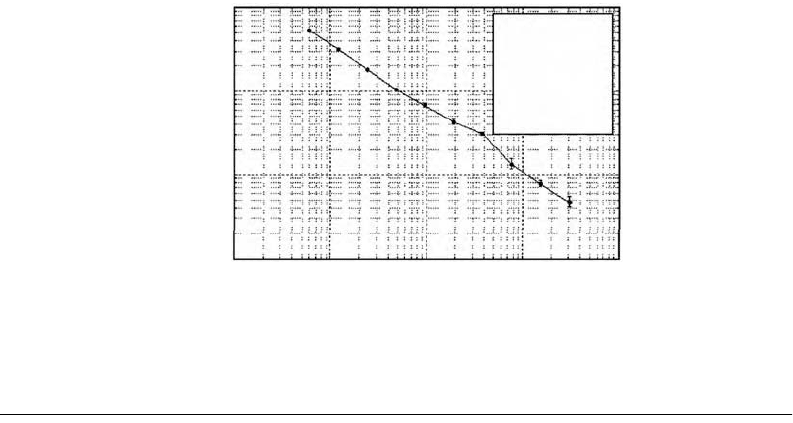
Fundamentals of Time and Frequency 18-17
18.5 Closing
As noted earlier, time and frequency standards and measurements have improved by about nine orders
of magnitude in the past 100 years. This rapid advance has made many new products and technologies
possible. While it is impossible to predict what the future holds, we can be certain that oscillator Qs will
continue to increase, measurement uncertainties will continue to decrease, and new technologies will
continue to emerge.
References
1. Jespersen, J., and Fitz-Randolph, J., From Sundials to Atomic Clocks: Understanding Time and Fre-
quency, 2nd ed., Dover, Mineola, New York, 1999.
2. Kamas, G., and Lombardi, M. A., Time and Frequency Users Manual, NIST Special Publication 559,
U.S. Government Printing Office, Washington, DC, 1990.
3. Levine, J., Introduction to time and frequency metrology, Rev. Sci. Instrum., 70, 2567, 1999.
4. Hackman, C., and Sullivan, D. B., Eds., Time and Frequency Measurement, American Association of
Physics Teachers, College Park, Maryland, 1996.
5. ITU Radiocommunication Study Group 7, Selection and Use of Precise Frequency and Time Systems,
International Telecommunications Union, Geneva, Switzerland, 1997.
6. Novick, A. N., Lombardi, M. A., Zhang, V. S., and Carpentier, A., A high performance multi-channel
time interval counter with an integrated GPS receiver, in Proc. 31st Annu. Precise Time and Time
Interval (PTTI) Meeting, Dana Point, California, p. 561, 1999.
7. Lombardi, M. A., Time measurement and frequency measurement, in The Measurement, Instrumen-
tation, and Sensors Handbook, Webster, J. G., Ed., CRC Press, Boca Raton, FL, 1999, chaps. 18–19.
8. Sullivan, D. B., Allan, D. W., Howe, D. A., and Walls, F. L., Eds., Characterization of Clocks and
Oscillators, NIST Technical Note 1337, U.S. Government Printing Office, Washington, DC, 1990.
9. Jespersen, J., Introduction to the time domain characterization of frequency standards, in Proc. 23rd
Annu. Precise Time and Time Interval (PTTI) Meeting, Pasadena, California, p. 83, 1991.
10. IEEE Standards Coordinating Committee 27, IEEE Standard Definitions of Physical Quantities for
Fundamental Frequency and Time Metrology—Random Instabilities, Institute of Electrical and Elec-
tronics Engineers, New York, 1999.
11. Walls, F. L., and Ferre-Pikal, E. S., Measurement of frequency, phase noise, and amplitude noise, in
Wiley Encyclopedia of Electrical and Electronics Engineering, John Wiley & Sons, New York, 1999,
12, 459.
FIGURE 18.14 Frequency stability of GPS receiver.
10
–11
10
–12
10
–13
10
–14
10
2
10
3
10
4
10
6
10
5
Averaging time, , seconds
τ
Allan deviation,
y
( )
σ
τ
Tau (s)
600
1200
2400
4800
9600
19200
38400
76800
153600
307200
Sigma
5.32e-12
3.19e-12
1.80e-12
1.04e-12
6.77e-13
4.82e-13
3.06e-13
1.33e-13
7.74e-14
7.70e-14
9258_C018.fm Page 17 Tuesday, October 2, 2007 1:22 AM
18-18 Mechatronic Systems, Sensors, and Actuators
12. Howe, D. A., An extension of the Allan variance with increased confidence at long term, IEEE Int.
Freq. Control Symp., 321, 1995.
13. Vig, J. R., Introduction to quartz frequency standards, Army Research and Development Technical
Report, SLCET-TR-92-1, October 1992.
14. Hewlett-Packard Company, Fundamentals of Quartz Oscillators, HP Application Note 200-2, 1997.
15. Carr, J. J., Elements of Electronic Instrumentation and Measurement, 3rd ed., Prentice-Hall, NJ, 1996.
16. Hoffmann-Wellenhof, B., Lichtenegger, H., and Collins, J., GPS: Theory and Practice, 3rd ed.,
Springer-Verlag, New York, 1994.
9258_C018.fm Page 18 Tuesday, October 2, 2007 1:22 AM

19-1
19
Sensor and Actuator
Characteristics
19.1 Range ........................................................................ 19-1
19.2 Resolution ................................................................. 19-2
19.3 Sensitivity .................................................................. 19-2
19.4 Error .......................................................................... 19-2
19.5 Repeatability ............................................................. 19-3
19.6 Linearity and Accuracy ............................................ 19-3
19.7 Impedance ................................................................ 19-4
19.8 Nonlinearities ........................................................... 19-5
19.9 Static and Coulomb Friction .................................. 19-5
19.10 Eccentricity ............................................................... 19-6
19.11 Backlash .................................................................... 19-6
19.12 Saturation ................................................................. 19-7
19.13 Deadband .................................................................. 19-7
19.14 System Response ...................................................... 19-8
19.15 First-Order System Response .................................. 19-8
19.16 Underdamped Second-Order System Response .... 19-9
19.17 Frequency Response ................................................. 19-12
Reference ............................................................................... 19-14
Mechatronic systems use a variety of sensors and actuators to measure and manipulate mechanical,
electrical, and thermal systems. Sensors have many characteristics that affect their measurement capa-
bilities and their suitability for each application. Analog sensors have an output that is continuous over
a finite region of inputs. Examples of analog sensors include potentiometers, LVDTs (linear variable
differential transformers), load cells, and thermistors. Digital sensors have a fixed or countable number
of different output values. A common digital sensor often found in mechatronic systems is the incremental
encoder. An analog sensor output conditioned by an analog-to-digital converter (ADC) has the same
digital output characteristics, as seen in Figure 19.1.
19.1 Range
The range (or span) of a sensor is the difference between the minimum (or most negative) and maximum
inputs that will give a valid output. Range is typically specified by the manufacturer of the sensor. For
example, a common type K thermocouple has a range of 800°C (from −50°C to 750°C). A ten-turn
potentiometer would have a range of 3600 degrees.
Joey Parker
University of Alabama
9258_C019.fm Page 1 Tuesday, October 2, 2007 1:24 AM
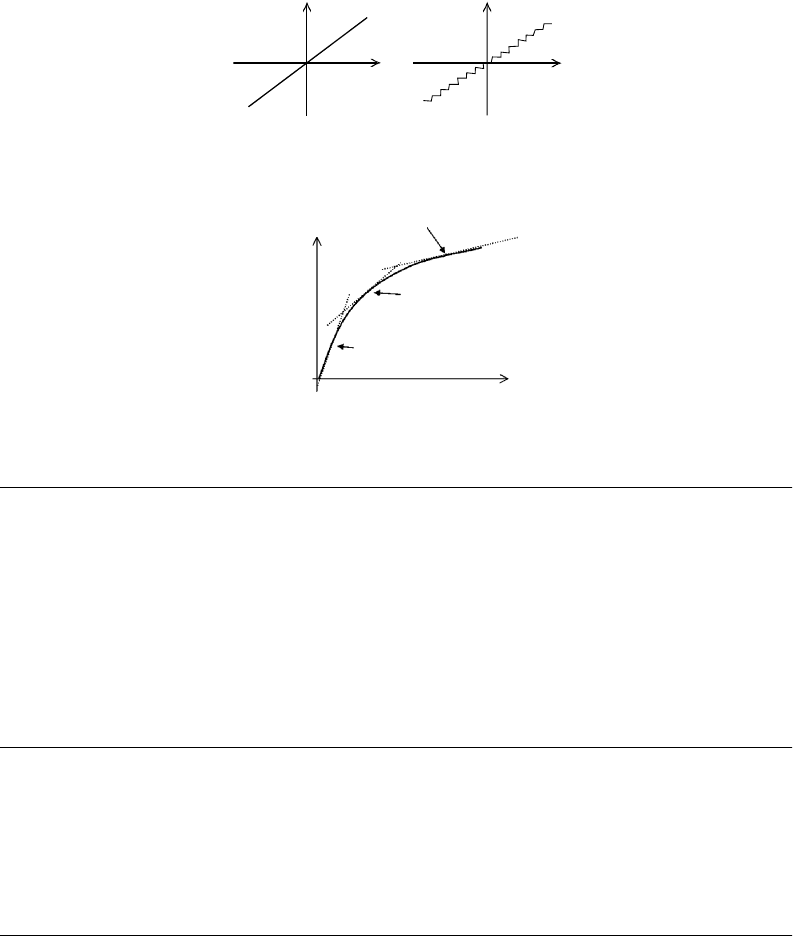
19-2 Mechatronic Systems, Sensors, and Actuators
19.2 Resolution
The resolution of a sensor is the smallest increment of input that can be reliably detected. Resolution is
also frequently known as the least count of the sensor. Resolution of digital sensors is easily determined.
A 1024 ppr (pulse per revolution) incremental encoder would have a resolution of
The resolution of analog sensors is usually limited only by low-level electrical noise and is often much
better than equivalent digital sensors.
19.3 Sensitivity
Sensor sensitivity is defined as the change in output per change in input. The sensitivity of digital sensors
is closely related to the resolution. The sensitivity of an analog sensor is the slope of the output versus
input line. A sensor exhibiting truly linear behavior has a constant sensitivity over the entire input range.
Other sensors exhibit nonlinear behavior where the sensitivity either increases or decreases as the input
is changed, as shown in Figure 19.2.
19.4 Error
Error is the difference between a measured value and the true input value. Two classifications of errors
are bias (or systematic) errors and precision (or random) errors. Bias errors are present in all measure-
ments made with a given sensor, and cannot be detected or removed by statistical means. These bias
errors can be further subdivided into
•
Calibration errors (a zero or null point error is a common type of bias error created by a nonzero
output value when the input is zero)
•
Loading errors (adding the sensor to the measured system changes the system)
•
Errors due to sensor sensitivity to variables other than the desired one (e.g., temperature effects
on strain gages)
FIGURE 19.1 Analog and digital sensor outputs.
FIGURE 19.2 Sensor sensitivity.
Analog
output
Digital
output
Input
Input
Low sensitivity
region
Intermediate
sensitivity region
High sensitivity
region
Input
Output
1 revolution
1024 pulses
------------------------------
360 degrees
1 revolution
------------------------------
× 0.3516
degrees
pulse
-----------------
=
9258_C019.fm Page 2 Tuesday, October 2, 2007 1:24 AM
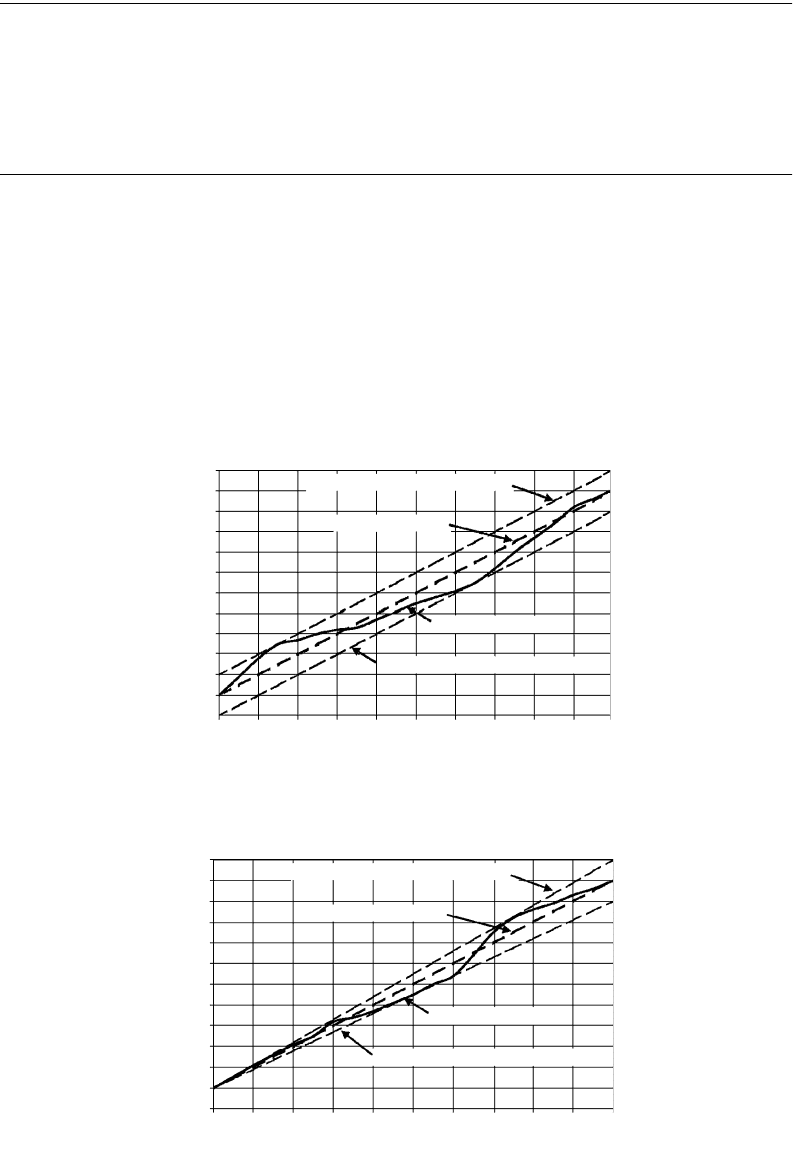
Sensor and Actuator Characteristics 19-3
19.5 Repeatability
Repeatability (or reproducibility) refers to a sensor’s ability to give identical outputs for the same input.
Precision (or random) errors cause a lack of repeatability. Fortunately, precision errors can be accounted
for by averaging several measurements or other operations such as low-pass filtering. Electrical noise and
hysteresis (described later) both contribute to a loss of repeatability.
19.6 Linearity and Accuracy
The accuracy of a sensor is inversely proportional to error, that is, a highly accurate sensor produces low
errors. Many manufacturers specify accuracy in terms of the sensor’s linearity. A least-squares straight-
line fit between all output measurements and their corresponding inputs determines the nominal output
of the sensor. Linearity (or accuracy) is specified as a percentage of full scale (maximum valid input), as
shown in Figure 19.3, or as a percentage of the sensor reading, as shown in Figure 19.4. Figures 19.3 and
19.4 show both of these specifications for 10% linearity, which is much larger than most actual sensors.
Accuracy and precision are two terms that are frequently confused. Figure 19.5 shows four sets of
histograms for ten measurements of angular velocity of an actuator turning at a constant 100 rad/s. The
first set of data shows a high degree of precision (low standard deviation) and repeatability, but the
FIGURE 19.3 Linearity specified at full scale.
FIGURE 19.4 Linearity specified at reading.
0
–10
0
10
10
20
20
30
Nominal straight line + 10% full scale
Nominal straight line + 10% full scale
Nominal straight line
Actual sensor output
30
40
40
Input (% full scale)
Output (% full scale)
50
50
60
60
70
70
80
80
90
90
100
100
110
0
–10
0
10
10
20
20
30
Nominal straight line + 10% of reading
Nominal straight line + 10% of reading
Nominal straight line
Actual sensor output
30
40
40
Input (% full scale)
Output (% full scale)
50
50
60
60
70
70
80
80
90
90
100
100
110
9258_C019.fm Page 3 Tuesday, October 2, 2007 1:24 AM
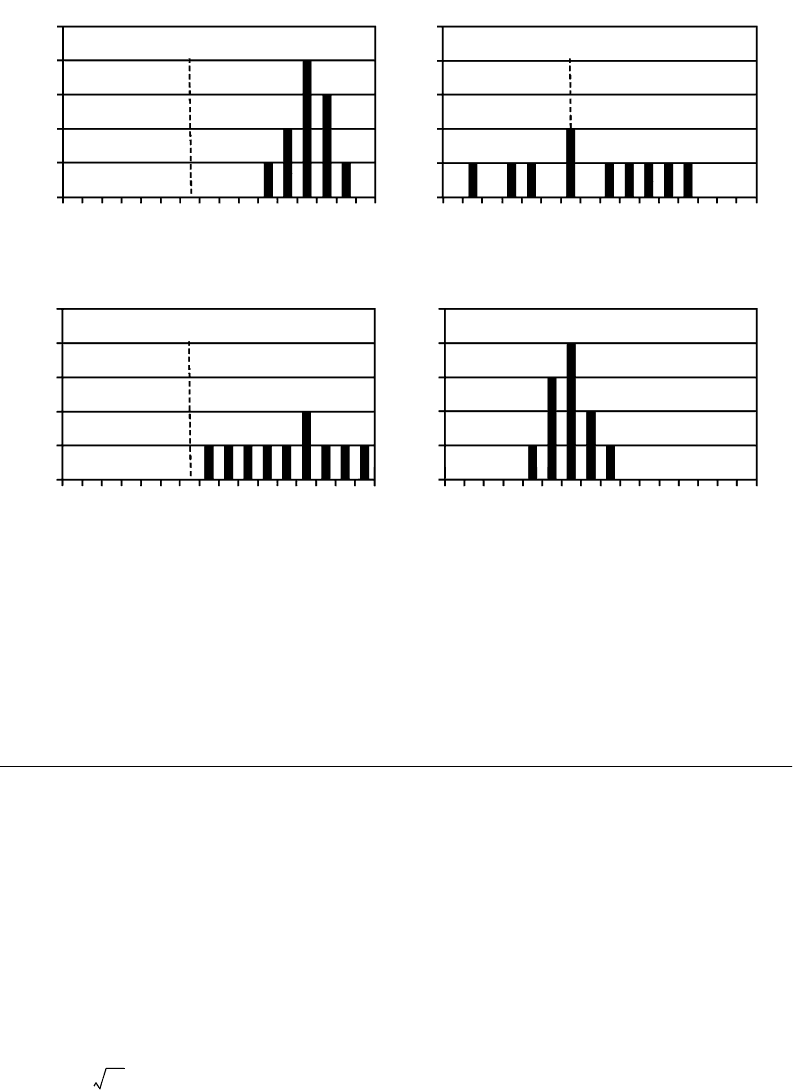
19-4 Mechatronic Systems, Sensors, and Actuators
average accuracy is poor. The second set of data shows a low degree of precision (high standard deviation),
but the average accuracy is good. The third set of data shows both low precision and low accuracy, while
the fourth set of data shows both high precision, high repeatability, and high accuracy.
19.7 Impedance
Impedance is the ratio of voltage and current flow for a sensor. For a simple resistive sensor (such as a
strain gage or a thermistor), the impedance Z is the same as the resistance R, which has units of ohms (Ω),
For more complicated sensors, impedance includes the effects of capacitance, C, and inductance, L.
Inclusion of these terms makes the impedance frequency sensitive, but the units remain ohms:
where is the imaginary number and
ω
is the driving frequency. The impedance form is
particularly nice for analyzing simple circuits, as parallel and series inductances can be treated just like
resistances. Two types of impedance are important in sensor applications: input impedance and output
impedance. Input impedance is a measure of how much current must be drawn to power a sensor (or
signal conditioning circuit). Input impedance is frequently modeled as a resistor in parallel with the
FIGURE 19.5 Examples of accuracy and precision.
Set 1: Precise, but not accurate Set 2: Accurate, but not precise
Set 3: Neither accurate nor precise Set 4: Both accurate and precise
Sensor output, rad/s
Sensor output, rad/s
True value
True value
Tr u e va lu e
5
4
3
2
1
0
5
4
3
2
1
0
5
4
3
2
1
0
94 96
98
100 102 104 106 108
94 96
98
100
102
104 106 108 94 96
98
100
102
104 106 108
94 96
98
100 102 104 106 108
5
4
3
2
1
0
True value
Sensor output, rad/s
Sensor output, rad/s
Z
R
V
I
---
R==
Z
C
V
I
---
1
jC
ω
-----------
and Z
L
V
I
---
jL
ω
== ==
j 1–=
9258_C019.fm Page 4 Tuesday, October 2, 2007 1:24 AM

Sensor and Actuator Characteristics 19-5
input terminals. High input impedance is desirable, since the device will then draw less current from the
source. Oscilloscopes and data acquisition equipment frequently have input impedances of 1 MΩ or more
to minimize this current draw. Output impedance is a measure of a sensor’s (or signal conditioning
circuit’s) ability to provide current for the next stage of the system. Output impedance is frequently
modeled as a resistor in series with the sensor output. Low output impedance is desirable, but is often
not available directly from a sensor. Piezoelectric sensors in particular have high output impedances and
cannot source much current (typically micro-amps or less). Op-amp circuits are frequently used to buffer
sensor outputs for this reason. Op-amp circuits (especially voltage followers) provide nearly ideal cir-
cumstances for many sensors, since they have high input impedance but can substantially lower output
impedance.
19.8 Nonlinearities
Linear systems have the property of superposition. If the response of the system to input A is output A,
and the response to input B is output B, then the response to input C (= input A + input B) will be output
C ( = output A + output B). Many real systems will exhibit linear or nearly linear behavior over some
range of operation. Therefore, linear system analysis is correct, at least over these portions of a system’s
operating envelope. Unfortunately, most real systems have nonlinearities that cause them to operate
outside of this linear region, and many common assumptions about system behavior, such as superpo-
sition, no longer apply. Several nonlinearities commonly found in mechatronic systems include static
and coulomb friction, eccentricity, backlash (or hysteresis), saturation, and deadband.
19.9 Static and Coulomb Friction
In classic linear system analysis, friction forces are assumed to be proportional to velocity, that is, viscous
friction. With an actuator velocity of zero, there should be no friction. In reality, a small amount of static
(no velocity) or Coulomb friction is almost always present, even in roller or ball type anti-friction
bearings. A typical plot of friction force versus velocity is given in Figure 19.6. Note that the static friction
force can assume any value between some upper and lower limit at zero velocity. Static friction has two
primary effects on mechatronic systems:
1. Some of the actuator torque or force is wasted overcoming friction forces, which leads to ineffi-
ciency from an energy viewpoint.
2. As the actuator moves the system to its final location, the velocity approaches zero and the actuator
force/torque will approach a value that exactly balances frictional and gravity loads. Since static
friction can assume any value at zero velocity, the actuator will come to slightly different final
resting positions each time—depending on the final value of static friction. This effect contributes
to some loss of repeatability in mechatronic systems.
FIGURE 19.6 Static and Coulomb friction.
Velocity
Actual
Linear (viscous)
Friction
force
9258_C019.fm Page 5 Tuesday, October 2, 2007 1:24 AM

19-6 Mechatronic Systems, Sensors, and Actuators
19.10 Eccentricity
The ideal relationships for gears, pulleys, and chain drives assume that the point of gear contact remains
at a fixed distance from the center of rotation for each gear. In reality, the true center of the gears pitch
circle and the center of rotation will be separated by a small amount, known as the eccentricity. Small
tooth-to-tooth errors can also cause local variations in the pitch circle radius. The combination of these two
effects can lead to a nonlinear geometrical relationship between two gears like that of Figure 19.7, where
the nonlinear behavior is greatly exaggerated for clarity. Eccentricity impacts the accuracy of position
measurements made on the input side of the gear pair, as the output gear is not exactly where the sensor
measurement indicates.
19.11 Backlash
If two otherwise perfect gears are not mounted on a center-to-center distance that exactly matches the
sum of the pitch radii, there will be a small clearance, or backlash, between the teeth. When the input
gear reverses direction, a small rotation is required before this clearance is removed and the output gear
begins to move. Gear backlash is just one of many phenomena that can be characterized as hysteresis,
as shown in Figure 19.8. Clearance between shafts and bearings can cause hysteretic effects also. Backlash
exhibits effects similar to those for eccentricity, that is, a loss of repeatability, particularly when approach-
ing a measured point from different directions. The gear backlash problem is so prevalent and potentially
harmful that many manufacturers go to great lengths to minimize or reduce the effect:
•
Gears mounted closer together than the theoretically ideal spacing
•
Split “anti-backlash” gears that are spring loaded to force teeth to maintain engagement at all times
•
External spring-loaded mounts for one of the gears to force engagement
•
Specially designed gears with anti-backlash features
FIGURE 19.7 Gear eccentricity.
FIGURE 19.8 Gear backlash.
Actual
Linear
out
θ
in
θ
Actual
θ
in
θ
out
Linear
9258_C019.fm Page 6 Tuesday, October 2, 2007 1:24 AM
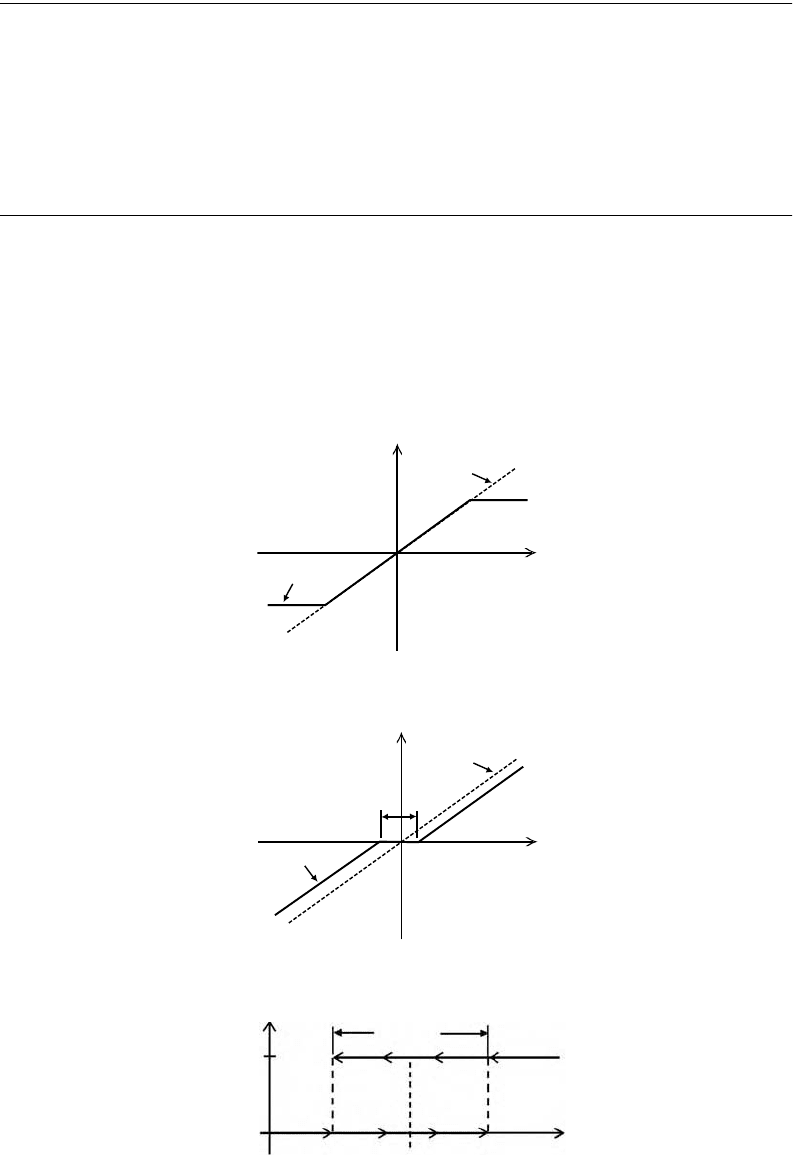
Sensor and Actuator Characteristics 19-7
19.12 Saturation
All real actuators have some maximum output capability, regardless of the input. This violates the linearity
assumption, since at some point the input command can be increased without significantly changing the
output; see Figure 19.9. This type of nonlinearity must be considered in mechatronic control system design,
since maximum velocity and force or torque limitations affect system performance. Control systems mod-
eled with linear system theory must be carefully tested or analyzed to determine the impact of saturation
on system performance.
19.13 Deadband
Another nonlinear characteristic of some actuators and sensors is known as deadband. The deadband is
typically a region of input close to zero at which the output remains zero. Once the input travels outside
the deadband, then the output varies with input, as shown in Figure 19.10. Analog joystick inputs
frequently use a small amount of deadband to reduce the effect of noise from human inputs. A very
small movement of the joystick produces no output, but the joystick acts normally with larger inputs.
Deadband is also commonly found in household thermostats and other process type controllers, as
shown in Figure 19.11. When a room warms and the temperature reaches the setpoint (or desired value)
FIGURE 19.9 Saturation.
FIGURE 19.10 Deadband.
FIGURE 19.11 Thermostat deadband.
Actual
Linear
Output
Input
command
Actual
Linear
Deadband
Output
Input
command
Output
Temperature
Deadband
Setpoint
OFF
ON
9258_C019.fm Page 7 Tuesday, October 2, 2007 1:24 AM
